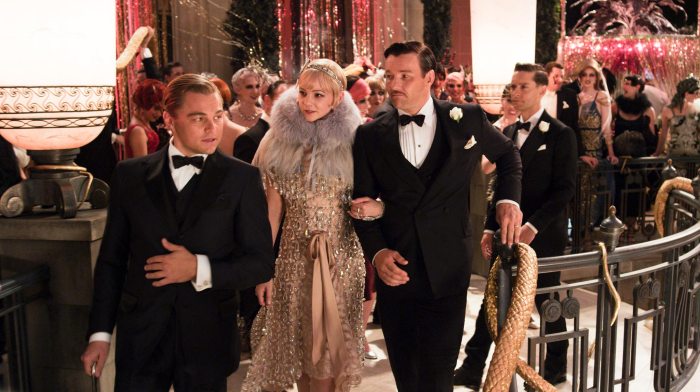Deception in The Great Gatsby unravels a tale of intrigue and illusion, where characters navigate a labyrinth of secrets, lies, and shattered dreams. This compelling narrative explores the profound impact of deception on individuals, relationships, and society, leaving readers captivated by its timeless relevance.
The novel delves into the motivations behind deceptive actions, the consequences they unleash, and the intricate web of trust, betrayal, and forgiveness that deception weaves.
Deception in Characters

Deception is a pervasive force in The Great Gatsby, shaping the lives of the characters and driving the plot forward. Characters engage in deception for a variety of reasons, from self-preservation to manipulation to the pursuit of their dreams.
Jay Gatsby
Gatsby is the most enigmatic character in the novel, and his life is built on a foundation of deception. He has invented a new identity for himself, concealing his humble beginnings and creating a glamorous persona to attract Daisy Buchanan.
Gatsby’s deception is motivated by his desire to win Daisy back. He believes that by creating a wealthy and successful image, he can impress her and make her forget her husband, Tom.
The consequences of Gatsby’s deception are ultimately tragic. Daisy is unable to reconcile the man she once knew with the wealthy and enigmatic Gatsby, and their relationship ends in disaster.
Daisy Buchanan
Daisy is also complicit in the deception that surrounds Gatsby. She allows him to believe that she still loves him, even though she is married to Tom and has no intention of leaving him.
Daisy’s deception is motivated by her desire for both security and excitement. She is attracted to Gatsby’s wealth and glamour, but she also knows that a relationship with him would be dangerous.
The consequences of Daisy’s deception are equally tragic. She is ultimately unable to choose between Gatsby and Tom, and her indecision leads to Gatsby’s death.
Tom Buchanan
Tom is the most openly deceptive character in the novel. He is a bully and a cheat, and he has no qualms about using deception to get what he wants.
Tom’s deception is motivated by his desire for control. He wants to maintain his position as the dominant male in his marriage, and he is willing to use any means necessary to do so.
The consequences of Tom’s deception are far-reaching. He destroys Gatsby’s life, and he drives Daisy to the brink of despair.
Deception in Relationships

The Great Gatsby is a novel that explores the destructive effects of deception. Many of the relationships in the novel are built on lies and secrets, which ultimately lead to betrayal and heartbreak.
Deception and Trust
One of the most important themes in The Great Gatsby is the importance of trust. When people deceive each other, they break the trust that is essential for any healthy relationship. This can lead to feelings of betrayal, anger, and resentment.
For example, Daisy Buchanan is married to Tom, but she has an affair with Gatsby. Daisy lies to Tom about her feelings for Gatsby, and she even tries to hide the affair from him. This deception destroys the trust between Daisy and Tom, and it ultimately leads to their divorce.
Deception and Forgiveness
Another important theme in The Great Gatsby is the question of forgiveness. When someone has been deceived, it can be difficult to forgive them. However, forgiveness is essential for healing and moving on from the past.
For example, Gatsby is deeply in love with Daisy, but she ultimately chooses Tom over him. Gatsby is heartbroken, but he eventually forgives Daisy. This forgiveness allows Gatsby to move on from the past and find happiness.
Deception in Society

Deception is a pervasive aspect of human interaction, shaping the fabric of society. Societal norms and values play a significant role in influencing the prevalence and acceptability of deception. In certain cultures, deception is seen as a necessary tool for maintaining social harmony and avoiding conflict, while in others, it is strongly condemned as a violation of trust.
The Role of Deception in Maintaining Social Order
Deception can serve as a mechanism for maintaining social order by smoothing over interpersonal interactions and preventing disruptions. It allows individuals to conceal their true feelings or intentions, thereby avoiding confrontations and preserving relationships. For example, in some societies, it is considered polite to engage in “white lies” to avoid causing offense or embarrassment.
The Ethical Implications of Deception
The ethical implications of deception vary depending on the context in which it occurs. In some cases, deception may be justified to protect individuals from harm or to prevent negative consequences. For example, a doctor may withhold information from a patient if they believe it would be detrimental to their health.
However, in other cases, deception can be unethical and harmful, particularly when it is used to manipulate or exploit others. The ethical considerations surrounding deception must be carefully weighed in each situation.
Deception in Symbolism

In “The Great Gatsby,” symbolism plays a pivotal role in revealing the deceptive nature of the characters, relationships, and society. Certain symbolic elements represent illusion and deception, contributing significantly to the novel’s exploration of the American Dream and the futility of chasing unattainable ideals.
The Green Light
One of the most prominent symbols of deception in the novel is the green light at the end of Daisy Buchanan’s dock. For Gatsby, this light represents his unattainable dream of rekindling his past love with Daisy. However, as the novel progresses, it becomes clear that the green light is a symbol of Gatsby’s own self-deception and the impossibility of recapturing the past.
The green light is also associated with the American Dream. Gatsby’s pursuit of Daisy and his lavish lifestyle symbolize his desire to achieve the ideal American life. However, the green light remains out of reach, suggesting that the American Dream is often an illusion that leads to disappointment and disillusionment.
The Great Gatsby is a story filled with deception, from the mysterious Jay Gatsby to the superficial Daisy Buchanan. But even in the midst of all this deceit, there are some truths that can be found. For example, the army iwq written test answers can be found here . This website provides a comprehensive guide to help you prepare for the army iwq written test.
By understanding the deception that is present in The Great Gatsby, we can better appreciate the truths that are hidden within.
Deception in Narrative Structure: Deception In The Great Gatsby

The structure of The Great Gatsbyand its narrative techniques contribute significantly to a pervasive sense of deception within the novel. The unreliable narrator, Nick Carraway, and the fragmented perspectives of various characters create a complex and often contradictory tapestry of events, leaving the reader questioning the true nature of the story.
Unreliable Narration
Nick Carraway, the narrator of the novel, is a complex and flawed character whose own biases and limitations shape the narrative. His perspective is often unreliable, as he admits to being “inclined to reserve all judgments” and to having “a peculiar sense of detachment.”
This detachment allows Nick to observe the events of the novel with a certain degree of objectivity, but it also limits his ability to fully understand and interpret them.
Fragmented Perspectives, Deception in the great gatsby
The novel is further complicated by the use of fragmented perspectives. The story is told through the eyes of multiple characters, each with their own unique biases and motivations. This fragmentation creates a sense of uncertainty and ambiguity, as the reader is never sure which perspective to trust.
The Novel’s Ending
The novel’s ending is particularly significant in its role in revealing and undermining the truth. The revelation of Gatsby’s true identity and the circumstances of his death shatter the illusions that have been carefully constructed throughout the novel. However, the ending also leaves many questions unanswered, suggesting that the full truth may never be known.
FAQs
What are the primary themes of deception explored in The Great Gatsby?
The novel explores deception in characters, relationships, society, symbolism, and narrative structure.
How does deception impact the characters in The Great Gatsby?
Deception leads to shattered dreams, broken relationships, and a profound sense of disillusionment among the characters.
What is the significance of the “green light” as a symbol of deception?
The green light represents Gatsby’s unattainable dream and the deceptive nature of his pursuit.
